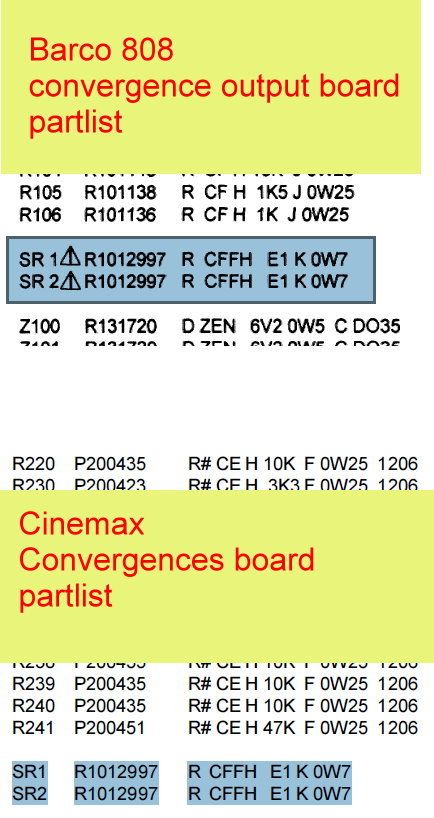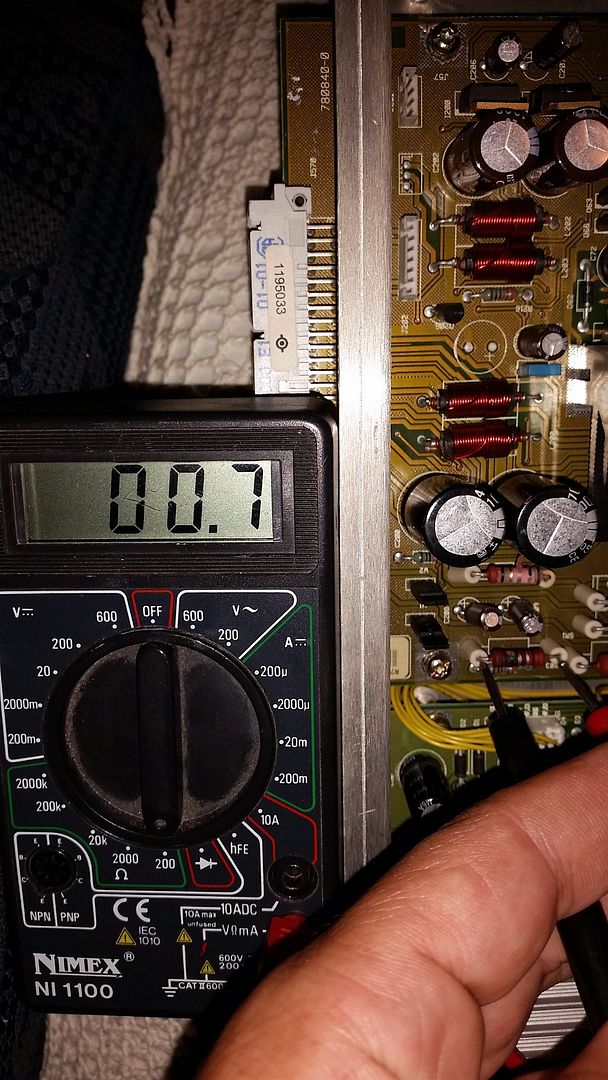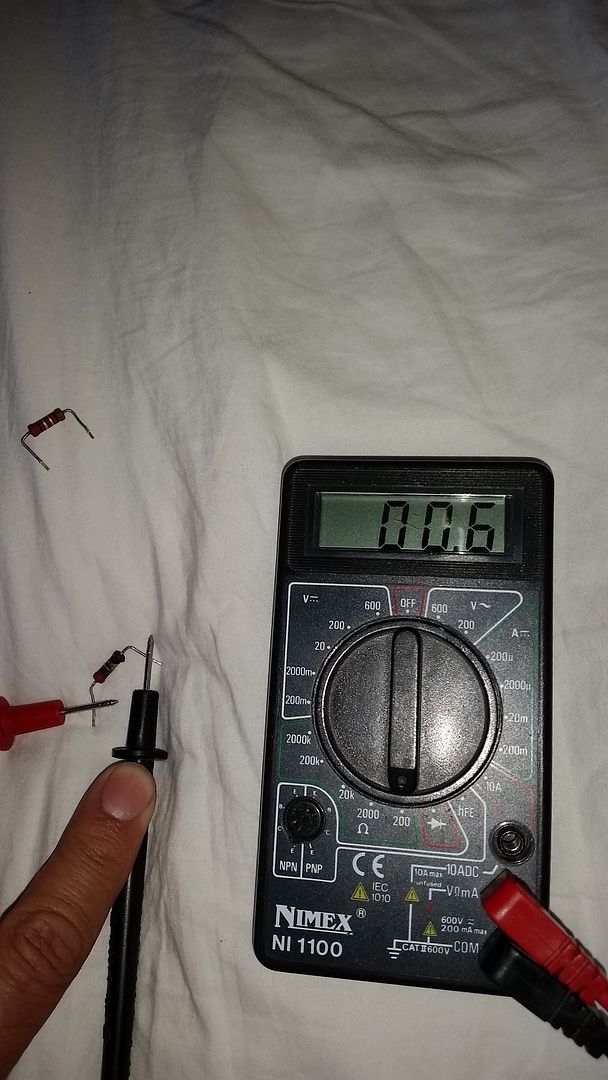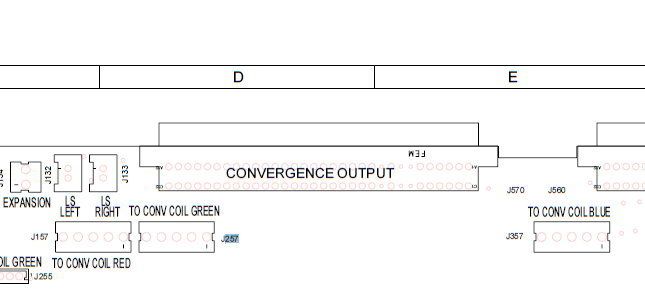|
|
Post by Decibel on Aug 11, 2015 17:51:40 GMT -5
I pulled the fresh Resistor from a donor Convergence Output board of one Barco 808 that I have. Now I have many doubts but I'm pretty sure that service manuals say that these resistors have same values. Tomorrow I'll read the values with meter. Yes they are same type, same values.  There's other SR resistor on the donor board. Tomorrow I'll check his value with meter. |
|
|
|
Post by mastertech on Aug 11, 2015 18:12:03 GMT -5
It is interesting that this was the choice of replacement since the originals are not fusible resistors. They are just classified as a safety resistor because of their use and placement in the circuit. A safety resistor is not necessarily a fusible resistor. The correct replacement would be a .1 ohm, 3/4 watt wirewound resistor. They are common and available but a little pricey compared to a plain resistor. You could probably even up that wattage to 1 watt without issue and then lots become available and at cheaper prices. Even switching over to a pigtail or pico fuse would be acceptable given the right amperage. This is what most RPTV's use for protection of the convergence output circuits of the same voltages and same current and even same ic amplifiers in some applications. |
|
|
|
Post by Decibel on Aug 11, 2015 22:22:10 GMT -5
This morning I check the value of first resistor that (apparently) burn.
Scale 200 ohm.
The meter show 0.7 ohm
|
|
|
|
Post by hulio on Aug 12, 2015 1:58:39 GMT -5
I pulled the fresh Resistor from a donor Convergence Output board of one Barco 808 that I have. Now I have many doubts but I'm pretty sure that service manuals say that these resistors have same values. Tomorrow I'll read the values with meter. Yes they are same type, same values.  L There's other SR resistor on the donor board. Tomorrow I'll check his value with meter. Decibel, i already posted on page 19 that all Barco series projectors ( from 7 to 9 ) used the same type and value SR1 and SR2 on their conv. boards and it would be easier to find a donor conv. board. I guess you missed that post ? |
|
|
|
Post by Decibel on Aug 12, 2015 2:25:04 GMT -5
Yes in fact I pulled a resistor from 808's convergence board.
|
|
|
|
Post by Decibel on Aug 12, 2015 11:31:48 GMT -5
Below check the SR resistors Picture one - check SR1 (SR2 was completely burned and dead)  Picture two - check the first toasted SR2  Picture three - check another SR resistor come from a donor Barco 808 board. This is a fresh (and last) resistor that I (could) put in Cinemax.  |
|
Deleted
Deleted Member
Posts: 0
|
Post by Deleted on Aug 12, 2015 11:57:27 GMT -5
Did you allready check those transistors close to these resistors? I still think one blew.
|
|
|
|
Post by mastertech on Aug 12, 2015 12:08:17 GMT -5
Ok, that is all I wanted. Was to see the value's of those SR's. And any time you replace any you should be checking the value before doing so.
So let's put the SR's to rest.
Now here is what I want you to do next. And if after you translate this there is anything you do not understand, ask question before going further. And follow these directions exactly as I say.
Of those 3 SR's you posted pictures of, they all still look ok. SO put 2 of the worst looking one's in for now, that test ok, so you are not ruining more until we get this straightened out.
Then remove the 2 jumpers, start the projector and neutral out all the convergence and geometry settings like I have already asked. Also see if those 2 SR's are hot. They should not be but post if they are before continuing.
Then shut projector down and put the 2 jumpers back on but disconnect "ALL" the convergence coils. Restart the projector and see if the SR's get hot. If they do then post back.
If they do not then shut down the projector and reconnect the convergence coils, restart the projector and see if they get hot. Post your results.
|
|
|
|
Post by Decibel on Aug 12, 2015 12:26:57 GMT -5
Can I replace the bad resistor? SR2 infact is totally dead. Can I temporarily solder the resistor of picture two (toasted but good) up on resistor burned? What are the convergences coils and how to disconnect they?
|
|
Deleted
Deleted Member
Posts: 0
|
Post by Deleted on Aug 12, 2015 12:43:43 GMT -5
The convergence coils are on the tubes. They connect to connectors on the motherboard in the tube housing that say conv. Easy to find.
|
|
|
|
Post by Decibel on Aug 12, 2015 12:51:28 GMT -5
Ah ok I always called deflection coils. Are these?
|
|
Deleted
Deleted Member
Posts: 0
|
Post by Deleted on Aug 12, 2015 13:06:14 GMT -5
Ah ok I always called deflection coils. Are these? They are in the same coil house but different wires. But the deflection coils have a connector called different. Be carefull with those deflection connectors. I once misplaced one and that blew my EHT. Look for "to conv coil red" etc. On the motherboard. |
|
|
|
Post by Decibel on Aug 12, 2015 13:36:52 GMT -5
Ah ok I always called deflection coils. Are these? They are in the same coil house but different wires. But the deflection coils have a connector called different. Be carefull with those deflection connectors. I once misplaced one and that blew my EHT. Look for "to conv coil red" etc. On the motherboard. Ok below the connectors of comvergence coils.  |
|
|
|
Post by Decibel on Aug 12, 2015 14:12:44 GMT -5
ok I just back to tests that Mastertech asked.
First of all I set all geometry and convergence to midpositions and erase all memory blocks.
First test:
- no jumpers
- conv coils connected
- resistors stay cold.
Second test:
- jumpers yes
- conv coils disconnected
- resistors stay cold.
I don't tried the third test (with jumpers and all connect) because is the condition where resistors suffered overheating until destruction.
|
|
Deleted
Deleted Member
Posts: 0
|
Post by Deleted on Aug 12, 2015 14:24:12 GMT -5
Now I wonder if you would connect the blue convergence if the resistors would heat. But wait for Mastertech!
|
|